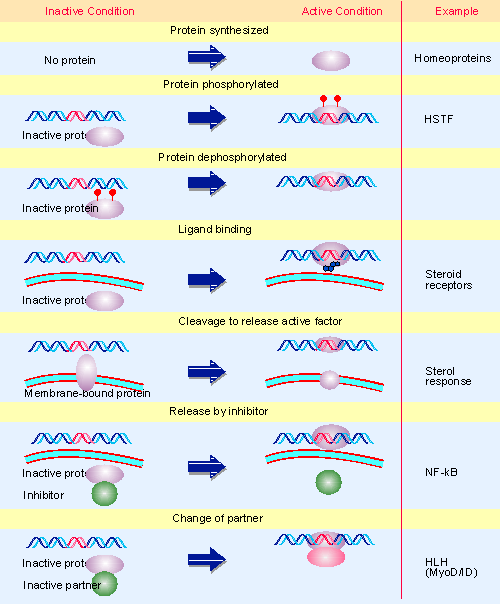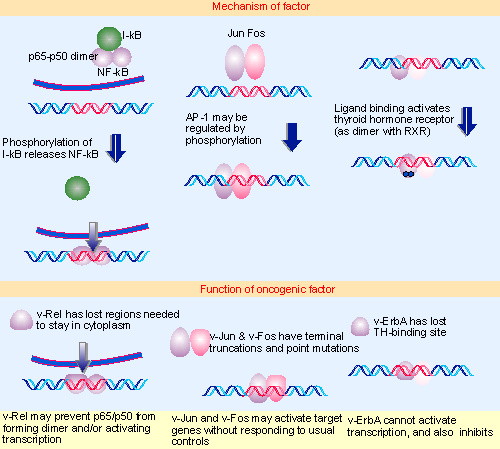3. There are many types of DNA-binding domains
21.3 There are many types of DNA-binding domains |
Comparisons between the sequences of many transcription factors suggest that it is common to have a modular structure in which different domains are responsible for binding to DNA and for activating transcription. Factors are often classified according to the type of DNA-binding domain. Typically a relatively short motif in this domain is responsible for binding to DNA:
- The steroid receptors are defined as a group by a functional relationship: each receptor is activated by binding a particular steroid. The glucocorticoid receptor is the most fully analyzed. Together with other receptors, such as the thyroid hormone receptor or the retinoic acid receptor, the steroid receptors are members of a superfamily of transcription factors with the same general modus operandi.
- The zinc finger motif comprises a DNA-binding domain. It was originally recognized in factor TFIIIA, which is required for RNA polymerase III to transcribe 5S rRNA genes. It has since been identified in several other transcription factors (and presumed transcription factors). A distinct form of the motif is found also in the steroid receptors(Miller et al., 1985) .
- The helix-turn-helix motif was originally identified as the DNA-binding domain of phage repressors. One α-helix lies in the wide groove of DNA; the other lies at an angle across DNA. A related form of the motif is present in the homeodomain, a sequence first characterized in several proteins coded by genes concerned with developmental regulation in Drosophila. It is also present in genes for mammalian transcription factors.
- The amphipathic helix-loop-helix (HLH) motif has been identified in some developmental regulators and in genes coding for eukaryotic DNA-binding proteins. Each amphipathic helix presents a face of hydrophobic residues on one side and charged residues on the other side. The length of the connecting loop varies from 12 V28 amino acids. The motif enables proteins to dimerize, and a basic region near this motif contacts DNA.
- Leucine zippers consist of a stretch of amino acids with a leucine residue in every seventh position. A leucine zipper in one polypeptide interacts with a zipper in another polypeptide to form a dimer. Adjacent to each zipper is a stretch of positively charged residues that is involved in binding to DNA.
 |
Figure 21.2 The activity of a regulatory transcription factor may be controlled by synthesis of protein, covalent modification of protein, ligand binding, or binding of inhibitors that sequester the protein or affect its ability to bind to DNA. Multiple figure |
The activity of an inducible transcription factor may be regulated in any one of several ways, as illustrated schematically in Figure 21.2:
- A factor is tissue-specific because it is synthesized only in a particular type of cell. This is typical of factors that regulate development, such as homeodomain proteins.
- The activity of a factor may be directly controlled by modification. HSTF is converted to the active form by phosphorylation. AP1 (a heterodimer between the subunits Jun and Fos) is converted to the active form by phosphorylating the Jun subunit.
- A factor is activated or inactivated by binding a ligand. The steroid receptors are prime examples. Ligand binding may influence the localization of the protein (causing transport from cytoplasm to nucleus), as well as determining its ability to bind to DNA.
- Availability of a factor may vary; for example, the factor NF-κB (which activates immunoglobulin κ genes in B lymphocytes) is present in many cell types. But it is sequestered in the cytoplasm by the inhibitory protein I-κB. In B lymphocytes, NF-κB is released from I-κB and moves to the nucleus, where it activates transcription.
- An extreme example of control of availability is found when a factor is actually part of a cytoplasmic structure, and is released from that structure to translocate to the nucleus.
- A dimeric factor may have alternative partners. One partner may cause it to be inactive; synthesis of the active partner may displace the inactive partner. We see later that such situations may be amplified into networks in which various alternative partners pair with one another, especially among the HLH proteins (Murre et al., 1989).
- The factor may be cleaved from an inactive precursor. One transcription factor is produced as a protein bound to the nuclear envelope and endoplasmic reticulum. The absence of sterols (such as cholesterol) causes the cytosolic domain to be cleaved; it then translocates to the nucleus and provides the active form of the transcription factor.
 |
Figure 28.19 Oncogenes that code for transcription factors have mutations that inactivate transcription (v-erbA and possibly v-rel) or that activate transcription (v-jun and v-fos). Multiple figure |
(We note en passant that mutations of the transcription factors in some of these classes give rise to factors that inappropriately activate, or prevent activation, of transcription; their roles in generating tumors are discussed in 28 Oncogenes and cancer, and Figure 28.19 should be compared with Figure 21.2.)
We now discuss in more detail the DNA-binding and activation reactions that are sponsored by some of these classes of proteins. In many cases, binding to DNA is undertaken by a short region of α-helix that makes contacts with either the bases or phosphate backbone in the major groove (for review see Harrison, 1991; Pabo and Sauer, 1992).
| Reviews | |
| Harrison, S. C. (1991). A structural taxonomy of DNA-binding proteins. Nature 353, 715-719. | |
| Pabo, C. T. and Sauer, R. T. (1992). Transcription factors: structural families and principles of DNA recognition. Ann. Rev. Biochem 61, 1053-1095. | |
| Research | |
| Miller, J. et al. (1985). Repetitive zinc binding domains in the protein transcription factor IIIA from Xenopus oocytes. EMBO J. 4, 1609-1614. | |
| Murre, C., McCaw, P. S., and Baltimore, D. (1989). A new DNA binding and dimerization motif in immunoglobulin enhancer binding, daughterless, MyoD, and myc proteins. Cell 56, 777-783. | |